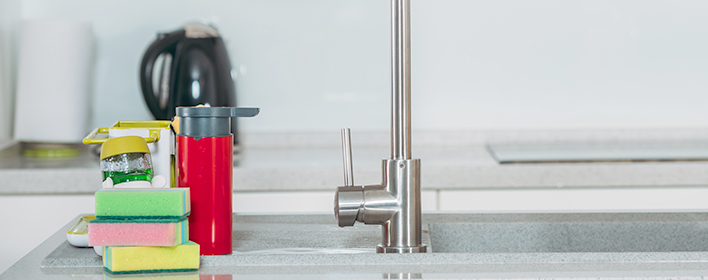
Kitchen a haven for germs
Think fast: What’s the most germ-infested room in the house? If you guessed the bathroom, you’re wrong. The kitchen earns the distinction, largely because of the sponges we use to clean our dishes and countertops.
Sponges are excellent at absorbing and retaining liquid, which is great for cleaning kitchen surfaces and soaking up spills, but those same properties can also be problematic when it comes to germ control. When a wet sponge sits, harmful bacteria can multiply, and when you go to wash your dishes and counters, you could be spreading around dangerous pathogens.
But a little hygiene can help keep your kitchen bug-free this cold and flu season. Here are 6 ways to get started:
Zap away bugs.
Kitchen sponges are the No. 1 source of germs in the whole house. Why? The moist, micro-crevices that make a sponge such an effective cleaning device also make it a cozy home for germs and more difficult to disinfect. Wiping your counters or dishes with a dirty sponge will only transfer the bacteria from one item to another. “Wet your sponge and then pop it in the microwave for two minutes to eliminate the germs that lurk inside the crevices”.
Practice good dishrag etiquette.
Your dish rags are really no better than your sponges. And like sponges, using a dirty dish rag to clean a kitchen countertop will only spread germs. Your best bet is to replace rags about once a week. “Allow them to dry out between uses because most bacteria thrive only in moistness,” In fact, they can only survive a few hours on dry surfaces. “Rags should be washed in the washing machine and then dried on high heat”.
Wipe away germs.
Faucet handles, refrigerator door handles, and doorknobs are next on the list of kitchen culprits that aid and abet germs. Use disinfectant spray or wipes on sink faucets, refrigerator handles, stove handles, cupboard handles, trashcans, doorknobs, and any other area that you touch with your hands. “These sprays or wipes kill germs on contact.” “This is really important and should be done several times a day before and after touching these objects.”
Clean the cutting board.
Cracks and crevices in your cutting board provide plenty of space for bacteria to grow. “The average cutting board has about 200% more fecal bacteria than the average toilet seat.” People don’t disinfect cutting boards, and they should. Don’t cut up chicken and then salad on the same cutting board without disinfecting it. Better yet, use separate boards for raw meat and making salads.
Dust out the drain.
The drains in both your kitchen sink and bathtub provide yet another moist hideaway for bacteria. To kill these bugs where they live use baking soda and an old toothbrush to get rid of stains, grit, and grime around drains.
Have it well-done.
Cooking food thoroughly and evenly will reduce the number of germs. Generally, the higher the temperature reached, the more germs are killed. “Also, wash salads, fruits, and vegetables thoroughly in clean water to remove all traces of soil, insects, or pesticides.”
